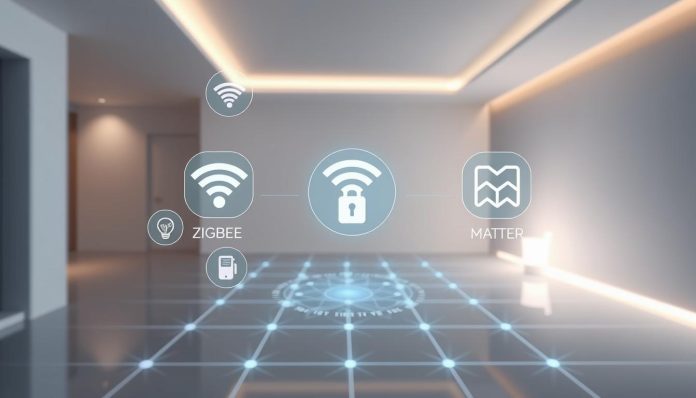When you dive into smart homes, you’ll find many protocols for device communication. Security is key, and knowing the differences is vital.
Zigbee, Z-Wave, WiFi, and Matter are the top protocols in smart homes. Each has its own unique features and security levels. It’s important to look at their strengths and weaknesses to find the most secure one.
More smart devices mean more security risks. Knowing how these protocols protect your home helps you choose wisely.
Key Takeaways
- Smart home protocols like Zigbee, Z-Wave, WiFi, and Matter have different security features.
- Understanding these differences is crucial for securing your smart home.
- The security of a protocol depends on its design and implementation.
- Each protocol has its strengths and weaknesses.
- Choosing the right protocol can enhance your smart home’s security.
Understanding Smart Home Protocols
Smart home protocols are key to your home’s function and safety. They let devices from different makers talk to each other smoothly. This makes your smart home work as one unit.
Knowing about these protocols is crucial when you want to make your smart home better. They help devices work together well. For example, your smart thermostat and lights can talk to each other. This makes your home more comfy and saves energy.
What Are Smart Home Protocols?
Smart home protocols are rules that guide how devices talk to each other. They set how devices send and get data, and how they react to commands. Common ones are Zigbee, Z-Wave, WiFi, and Matter.
These rules are important for devices to work together. Without them, devices from different makers might not talk to each other. This limits what your smart home can do.
Importance of Security in Smart Homes
Security is a big deal in smart homes. As your home gets more connected, it faces more risks. A good smart home protocol keeps your devices and data safe from hackers.
Important security features include encryption, authentication, and safe data sharing. A strong protocol protects against hacking. It keeps your smart home a safe place.
It’s important to know about these security steps when you’re setting up your smart home. By picking protocols that focus on security, you can enjoy a connected home safely.
Overview of Zigbee
Zigbee is a low-data-rate wireless protocol used in home automation. It follows the IEEE 802.15.4 standard. This makes it perfect for smart homes where saving energy is key.
Key Features of Zigbee
Zigbee is great for smart home devices because of its features. These include:
- Low Power Consumption: Zigbee devices use very little power. This means they can run for a long time on one battery.
- Mesh Networking: Zigbee uses mesh networking. This lets devices talk directly to each other, making the network more reliable and wide-reaching.
- Scalability: Zigbee networks can handle lots of devices. This makes it easy to grow your smart home system.
Security Measures in Zigbee
Security is very important in smart home protocols. Zigbee has several ways to keep communication safe. These include:
- AES-128 Encryption: Zigbee encrypts data with AES-128. This keeps data safe from unauthorized access.
- Secure Key Exchange: Zigbee securely shares encryption keys between devices. This ensures data stays protected.
- Device Authentication: Zigbee checks devices’ identities before they join the network. This stops unauthorized devices from getting in.
| Security Feature | Description | Benefit |
|---|---|---|
| AES-128 Encryption | Uses 128-bit AES for data encryption | Provides robust data protection |
| Secure Key Exchange | Ensures secure sharing of encryption keys | Prevents key compromise |
| Device Authentication | Verifies device identity before network access | Prevents unauthorized network access |
In summary, Zigbee is a top choice for smart homes. It’s low power, has mesh networking, and is very secure. Knowing about its features and security helps you see why Zigbee is so valuable for your smart home.
Overview of Z-Wave
Z-Wave is a top choice for smart home connectivity. It’s known for being reliable and secure. This wireless technology lets devices talk to each other, making your home a network of smart devices.
Key Features of Z-Wave
Z-Wave uses a low-frequency radio band. This means less interference from things like Wi-Fi routers and microwaves. Your smart devices stay connected better.
Some key features of Z-Wave are:
- Low-Frequency Operation: Minimizes interference from other household devices.
- Interoperability: Allows devices from different manufacturers to work together seamlessly.
- Mesh Network Topology: Enables devices to communicate with each other directly, improving network reliability.
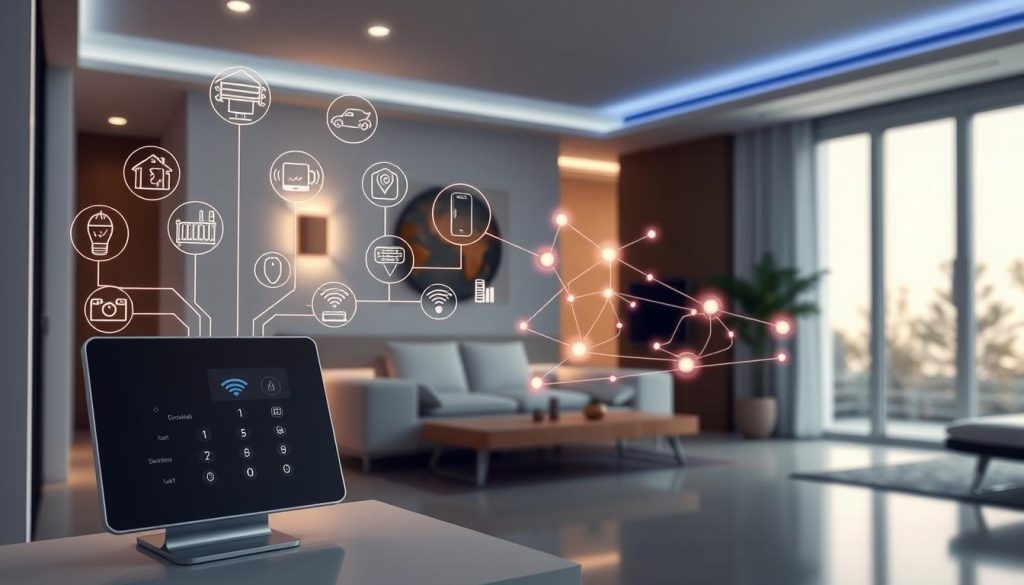
Security Measures in Z-Wave
Z-Wave has strong security to keep your smart home devices safe. It includes:
| Security Feature | Description |
|---|---|
| AES-128 Encryption | Provides robust encryption to secure data transmission between devices. |
| Secure Communication Protocols | Ensures that devices authenticate with each other before communicating. |
| Network Key Management | Manages network keys to control device access to the Z-Wave network. |
With these security features, Z-Wave makes your smart home devices safe. This lets you enjoy the benefits of smart home automation without worry.
Overview of WiFi
WiFi is a key part of smart homes because it’s fast and works with many devices. It uses the 2.4 GHz and 5 GHz bands. This makes it a top choice for smart home setups.
Key Features of WiFi
WiFi has features that make it great for smart homes. These include:
- High Data Transfer Rates: WiFi is fast, allowing devices to talk to each other easily.
- Widespread Adoption: Most devices support WiFi, making it simple to add to your network.
- Convenience: WiFi means no extra wiring, making it easy to place devices anywhere.
Security Measures in WiFi
Keeping WiFi secure is vital for smart homes. Important security steps include:
- WPA2 Encryption: WiFi uses WPA2 to keep data safe as it moves between devices.
- Secure Authentication Protocols: WiFi has secure ways to make sure only approved devices can join.
Even with these steps, WiFi can still face threats like hacking. So, it’s important to update your router and use strong passwords regularly.
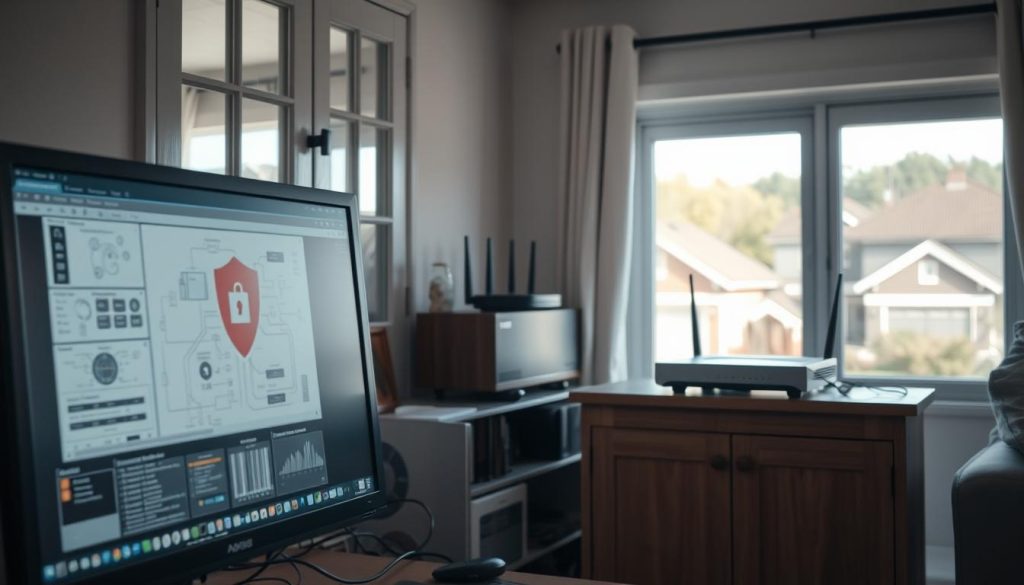
In summary, WiFi is a favorite for smart homes because it’s fast and works well with many devices. But, we must remember its security risks and take steps to protect it.
Overview of Matter
Smart home technology is getting better, thanks to a new protocol called Matter. It makes your smart home easier and safer. Matter works with WiFi and Thread to keep your home devices safe from threats.
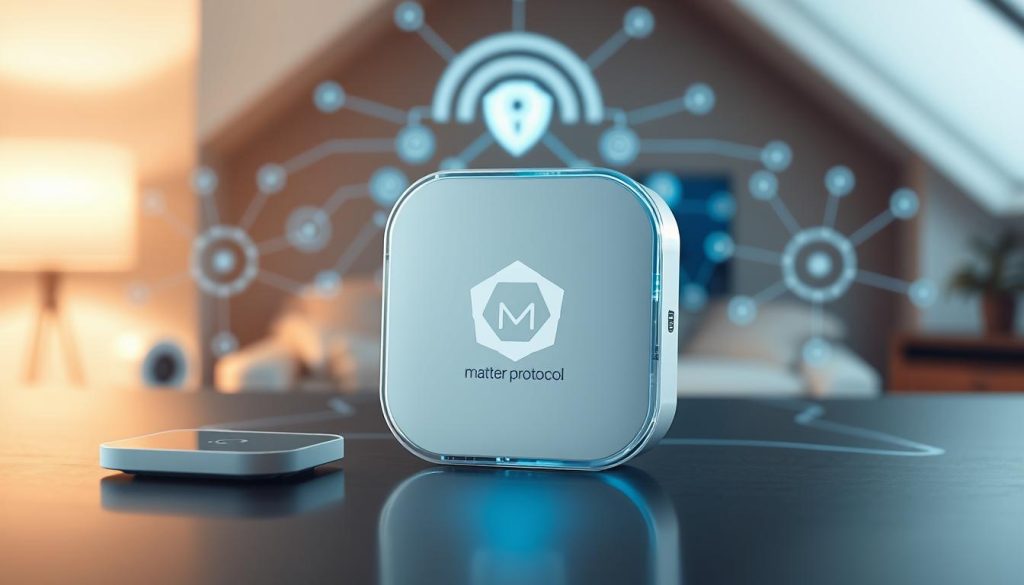
Key Features of Matter
Matter has some great features for smart home users. Here are the main benefits:
- Interoperability: Matter lets devices from different makers work together smoothly.
- Enhanced Security: It adds strong security to keep your devices safe from hackers.
- Simplified Setup: Matter makes setting up your smart home devices easy and fast.
How Matter Enhances Security
Matter improves security in many ways. This makes your smart home safer. Here are some key ways it does this:
| Security Feature | Description | Benefit |
|---|---|---|
| End-to-End Encryption | Matter uses end-to-end encryption to protect data between devices. | Keeps your data safe and private. |
| Secure Authentication | Matter uses secure ways to check if devices are real. | Blocks fake devices from getting into your network. |
| Regular Security Updates | Matter helps keep devices safe by updating them often. | Protects your devices from new threats. |
Matter is changing the smart home world for the better. It brings together different systems and adds strong security. If you choose Matter, you’ll get a safer, easier, and more connected smart home.
Comparing the Security Features
Exploring smart home devices means knowing about their security. The safety of your home depends on how well a protocol protects your data and devices.
Encryption Methods
Encryption is key for smart home security. Various protocols use different encryption methods to keep your data safe.
Zigbee and Z-Wave use AES-128 encryption, a strong way to secure data. WiFi, on the other hand, uses WPA2 or WPA3, which are top standards for wireless networks.
| Protocol | Encryption Method |
|---|---|
| Zigbee | AES-128 |
| Z-Wave | AES-128 |
| WiFi | WPA2/WPA3 |
| Matter | AES-128 & Other Secure Methods |
Authentication Protocols
Authentication is crucial for smart home security. It makes sure only approved devices can join your network.
Zigbee and Z-Wave use unique device identifiers and secure key exchange mechanisms for strong authentication. WiFi also uses WPA2/WPA3 authentication for secure device access.
Data Privacy Measures
Data privacy is a big concern in smart homes. Protocols like Matter focus on enhanced data privacy measures. They ensure your data is safe and private.
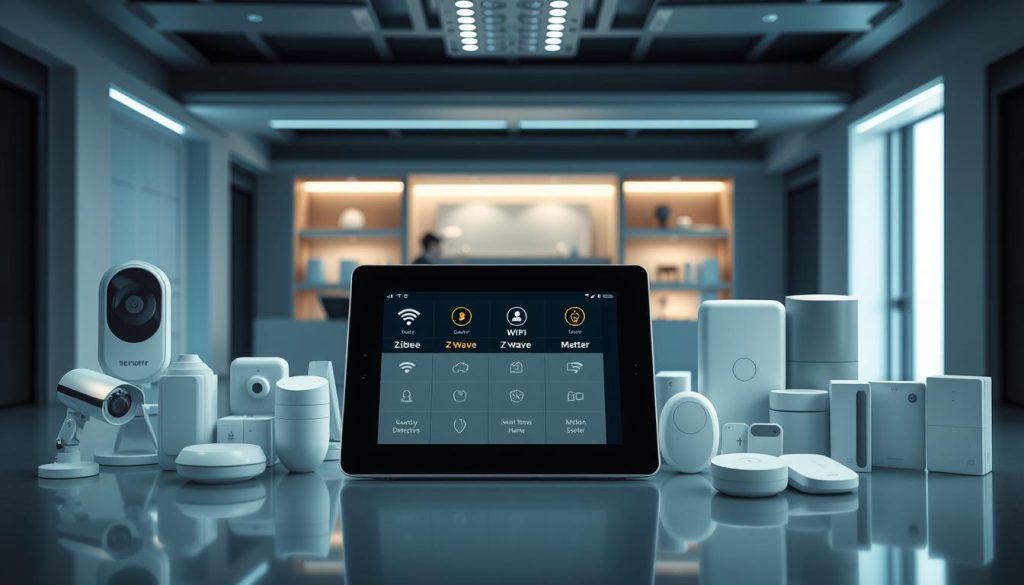
In summary, each protocol has its own security strengths and weaknesses. Knowing these differences is essential for keeping your smart home safe.
Practical Applications of Each Protocol
Different smart home protocols, like Zigbee, Z-Wave, WiFi, and Matter, meet different needs. When setting up your smart home, knowing these uses helps you choose the right devices. It also makes integrating them easier.
Use Cases for Zigbee
Zigbee is great for home automation, especially for lights and thermostats. It uses little power and forms a mesh network. For example, Philips Hue bulbs use Zigbee for easy lighting control.
- Home automation devices
- Lighting control systems
- Thermostat regulation
Use Cases for Z-Wave
Z-Wave is popular for home automation, focusing on security. It’s used in door locks, alarm systems, and more. For instance, August smart locks use Z-Wave for secure connections.
| Device Type | Z-Wave Application |
|---|---|
| Door Locks | Secure locking mechanisms |
| Alarm Systems | Reliable alert notifications |
Use Cases for WiFi
WiFi is key for smart homes needing high bandwidth, like cameras and streaming devices. It’s easy to use with home networks. For example, Nest cameras stream video over WiFi.
Use Cases for Matter
Matter aims to unite different ecosystems, making things easier. It’s great for mixing devices from various brands. This ensures a smooth smart home experience.
- Cross-ecosystem compatibility
- Enhanced device interoperability
- Simplified smart home management
Strengths and Weaknesses
It’s important to know the strengths and weaknesses of Zigbee, Z-Wave, WiFi, and Matter for your smart home. Each has its own good points and areas for improvement.
Zigbee vs. Z-Wave Security
Zigbee and Z-Wave are big names in smart home tech. Zigbee shines with its low power use and mesh network, making devices talk to each other easily. But, it has faced security issues, like the Zigbee exploit that let hackers into devices.
Z-Wave, however, is known for its strong security. It uses advanced encryption and works on a different frequency than Zigbee. This might make it safer in some places. Still, no tech is completely safe from threats.
WiFi’s Vulnerabilities
WiFi is popular for smart home devices because it’s easy to use and everywhere. But, WiFi’s big weakness is its openness. Being used by so many, it’s a favorite target for hackers. Weak passwords and old security can leave WiFi open to attacks.
Matter’s Advantages
Matter is a new tech aimed at fixing some old problems. Matter’s big plus is its unified way of making devices from different makers talk securely. It uses advanced encryption and secure ways to log in to make homes safer.
Looking at these protocols, Matter could really help make smart homes safer. But, how safe your home is depends a lot on how well these techs are set up and kept up.
Recommendations for Smart Home Users
As a smart home user, it’s important to know about different protocols. Your choice of protocol affects your home’s security and how well it works.
Choosing the Right Protocol for Your Needs
Think about the devices you have and how big your smart home is. For lots of devices, Zigbee or Z-Wave is good because they handle many devices well.
If your devices use WiFi, make sure your network is safe. Use a strong password and WPA3 encryption for better security.
Tips for Enhancing Smart Home Security
There are steps you can take to make your smart home more secure, no matter the protocol:
- Keep your devices’ firmware up to date to avoid security issues.
- Use a secure network for your smart home devices. You might want to keep them separate from your main network.
- Use strong authentication methods like two-factor authentication when you can.
By following these tips and picking the right protocol, you can make your smart home more secure and connected.
The best smart home protocol is one that fits your needs and keeps your devices safe. Knowing your options and taking steps to secure your home lets you enjoy a connected home safely.
Conclusion: The Future of Smart Home Protocols
The smart home industry is growing fast. Secure wireless and home automation protocols are key to its future. You’re leading the way, with new tech solving security and connection issues.
Emerging Trends
New tech will make your smart home safer. Advances in secure wireless protocols will protect your devices better. Artificial intelligence and machine learning will add to the security.
Innovation in Protection
Innovation is crucial for home automation security. As tech gets better, expect stronger encryption and authentication. This will keep your smart home safe.
Work on secure wireless and home automation protocols will keep your smart home safe. It will offer a more secure and connected experience.
